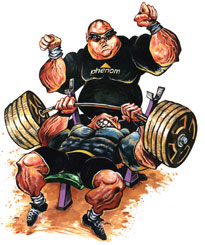
Occasionally, there are athletes whose complete mastery of one aspect of physicality wow us to the point of declaring them some variation of the greatest or the strongest athlete alive. Still, Max Strength, the ability to lift humongous amounts of weights will never fail to fascinate us all to no end. It'll force our ass into our respective workout locations in the hopes of capturing even a fraction of that kind of greatness. It's the reason why we admire bears, bulls, and diesel engines. Max strength will always be the gold standard of measuring physical greatness.

So, why train with Bodyweight if it doesn't get us to that gold standard?
Simple: that rabid, myopic focus on max strength as the only standard kind of sucks. Our bodies have lots of different ways of overcoming resistance. We have different ways of creating power. We're made to move in a lot of different ways. So, keeping all of the emphasis on just being able to lift the biggest shit off the ground doesn't make a lot of sense.
Fitness loves to specialize, when you really look closely. Many of the athletic achievements that we adore so much are the result of a person doing one thing with remarkable success. When you get right down to it, however, they're just playing. Others who need their body for real life stuff other than for games scoff at body-gamers. My dad has always been fond of looking at Bodybuilders and asking how much dirt they could shovel. How well could some powerlifters do hiking the Grand Canyon?
In my opinion, the body is at its best when it's an SUV: capable of doing lots of stuff with relative ease. It should be a more general-purpose vehicle. I'm not going to deny that some people will always excel at some tasks better than the other but it should have some general competence in a lot of different things. Training to lift hundreds of pounds often times runs counter to that mission.
Besides, it's not like you can't get milk a lot of max strength benefits out of Bodweight. You just have to avoid the falling into the conventional groove of only doing BW for more reps. Take this elevated one-arm push-up here:

How many people could do this push-up for 20 reps each arm? According to research (that I trust) and personal experience (mine and others), that's the drop-off point for getting max strength benefits out of an exercise. After that, it's a strength-endurance exercise. The fact is, many people could work at this for a while before it loses max strength benefit. So, even if it's second to weight training in this category, it's still a very strong one.








